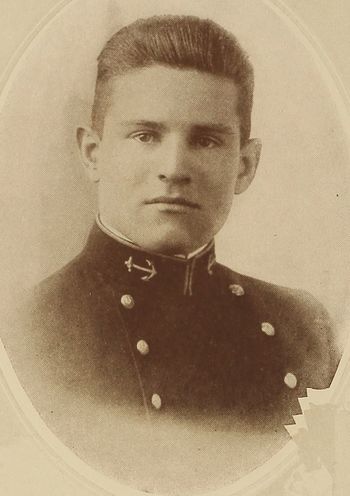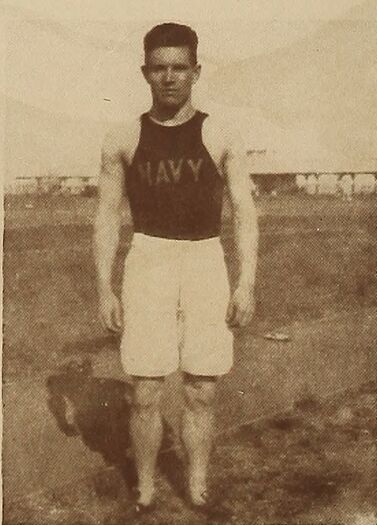EDWARD L. ERICSSON, LT, USN
Edward Ericcson '16
Lucky Bag
From the 1916 Lucky Bag:
Edward Lewis Ericsson
Westhampton, New York
"Swede" "Eric"
A DARK-HAIRED Swede is one of nature's paradoxes, worthy to rank with Johnnie Walker. Aside from this lapse, Eric is as rational, level-headed a chap as an analysis of the Class of 1916 can produce. In fact, his roommate claims he's not merely level headed, but that he can stand on any corner of the aforementioned cranium. This is base libel. We know for a fact that the best he can do is to rest comfortably on his dome, with his hands off the deck.
Aside from the rectangular qualities of his hat-rack, his ideas and statements are not so much well rounded as capable of being tied up in little square packages and shipped by freight, C. O. D.
El Sueco is one of the original strongmen. With a figure like Sandow's, he has systematically made himself strong, stronger and strongest, and few wrestlers can hope to capsize this staunch young bullock. Likewise, he runs like a deer and is the modest possessor of a medal for being in on the original breaking of the Academy relay record. In football he held down the job of bossing the class team and the hustlers from the strategic position of quarterback. While engaged in this duty, he called forth from some fair admirer—"Why—he looks like a little general!"
The Swede's strongest point is efficiency, and in search of this his natural inquisitiveness has led him into many kinds of hairbreadth adventures, such as saving drowning men, putting his fingers in things, etc.
He has a little philosophy, of the type peculiar to all backwoodsmen, such as there was in Lincoln. Wanting to know the why and wherefore has caused him to discover a great many of the basic truths of life, and he has applied them with quaint consistency to his ideas and actions. Though by no means to the exclusion of his "more deadly" friends, he is a man's man, and the most lovable chap imaginable. Stay with 'em, Swede, and you'll raise a bump on that bean yet!
One Stripe; Track Team (3, 2, 1); Track (N); Wrestling Team (2); wNt; Football Numerals; Varsity Football Squad (4, 1); Captain Class Football Team (3, 2); Basketball Numerals; Track Numerals; Treasurer Midshipmen's Athletic Association; Assistant Manager Swimming (2).

Edward Lewis Ericsson
Westhampton, New York
"Swede" "Eric"
A DARK-HAIRED Swede is one of nature's paradoxes, worthy to rank with Johnnie Walker. Aside from this lapse, Eric is as rational, level-headed a chap as an analysis of the Class of 1916 can produce. In fact, his roommate claims he's not merely level headed, but that he can stand on any corner of the aforementioned cranium. This is base libel. We know for a fact that the best he can do is to rest comfortably on his dome, with his hands off the deck.
Aside from the rectangular qualities of his hat-rack, his ideas and statements are not so much well rounded as capable of being tied up in little square packages and shipped by freight, C. O. D.
El Sueco is one of the original strongmen. With a figure like Sandow's, he has systematically made himself strong, stronger and strongest, and few wrestlers can hope to capsize this staunch young bullock. Likewise, he runs like a deer and is the modest possessor of a medal for being in on the original breaking of the Academy relay record. In football he held down the job of bossing the class team and the hustlers from the strategic position of quarterback. While engaged in this duty, he called forth from some fair admirer—"Why—he looks like a little general!"
The Swede's strongest point is efficiency, and in search of this his natural inquisitiveness has led him into many kinds of hairbreadth adventures, such as saving drowning men, putting his fingers in things, etc.
He has a little philosophy, of the type peculiar to all backwoodsmen, such as there was in Lincoln. Wanting to know the why and wherefore has caused him to discover a great many of the basic truths of life, and he has applied them with quaint consistency to his ideas and actions. Though by no means to the exclusion of his "more deadly" friends, he is a man's man, and the most lovable chap imaginable. Stay with 'em, Swede, and you'll raise a bump on that bean yet!
One Stripe; Track Team (3, 2, 1); Track (N); Wrestling Team (2); wNt; Football Numerals; Varsity Football Squad (4, 1); Captain Class Football Team (3, 2); Basketball Numerals; Track Numerals; Treasurer Midshipmen's Athletic Association; Assistant Manager Swimming (2).
Loss
Edward was lost on October 26, 1922 when the training plane he was aboard crashed at Naval Air Station Hampton Roads, Virginia. The other officer aboard was also killed.
Other Information
From Army-Navy-Air Force Register and Defense Times:
Lieutenant Edward L. Ericsson and Lieutenant Roger F. Armstrong, U. S. Navy, were killed instantly in a nose dive of the machine in which they were flying near No. 1 hangar at Hampton Roads operating base Thursday afternoon. Both were regarded as skillful flyers, and the details of the exact cause of the accident are lacking as our account closed.
Lieutenant Ericsson commanded the squadron of seaplanes which attacked the fleet in the recent maneuvers and was scheduled to command a squadron to fly over Norfolk the following day in celebration of Navy Day.
From Find A Grave (for the other officer aboard the plane):
TWO OFFICERS KILLED IN NAVAL PLANE CRASH
Lieutenants E. L. Ericsson and R. F. Armstrong Fall At Hampton RoadsNORFOLK, Virginia, October 26, 1922 – Lieutenants E. L. Ericsson and R. F. Armstrong were instantly killed this afternoon when a JN-4 training plane fell 800 feet at the Hampton Roads Naval Air Station.
The two naval officers had gone for a test flight. Suddenly their plane dropped almost vertically from a height of 800 feet. The first persons to reach the scene of the accident found both officers dead.
At the Naval Air Station it was said that both officers had been there about eighteen months, most of the time on duty with the torpedo training squadron. An inquiry into the cause of the accident was ordered.
At the Navy Department, Lieutenant Ericsson's home address was given as West Hampton Beach, New York, while Lieutenant Armstrong, who was formerly from New Rochelle, New York, was said to have lately changed his residence to Norfolk.
From researcher Kathy Franz:
At Westhampton High School, Edward was a member of the football, baseball, basketball, and track teams. He then served two years on the New York training ship Newport. In October 1910, he was offered the berth of fourth officer on the American liner St. Paul. He turned the offer down to continue his studies for the Naval Academy.
Edward received his appointment to the Naval Academy from Congressman Littleton. His summer cruise in 1914 was on the Illinois, the Kansas, and the Maine. The Pope in Rome gave the crews his blessings, just a short time before his death. In May 1916, Edward’s name was engraved on the Association Trophy Cup in honor of his selection as the midshipman who did the most to promote athletics.
In November 1921, he was promoted to second in command of the Atlantic Fleet Torpedo Plane Squadron. In September 1922, he was in command of the seaplanes which “attacked” ships of the Atlantic fleet with torpedoes hurled from the air.
The day after his death, he was to command six torpedo planes in a flight over Norfolk for its navy day celebration.
Edward was a member of the Presbyterian Church. His father John was a private estate gardener who was born in Sweden and naturalized in 1890. In 1902, his father was manager of a general farm in Southampton. Edward’s mother Rosie Mary was born in Germany. His brother Hampton (’24) became a U. S. Navy commander.
Edward is buried in New York. He was survived by a brother, Hampton M. Ericsson '24 (who passed away in December 1968, per the March 1969 issue of Shipmate).
He authored a piece for the Proceedings of the US Naval Institute that was published posthumously: "Maneuvering Aircraft In Formation."
Photographs
Related Articles
Roger Armstrong '18 was also lost in this crash.
The "Register of Commissioned and Warrant Officers of the United States Navy and Marine Corps" was published annually from 1815 through at least the 1970s; it provided rank, command or station, and occasionally billet until the beginning of World War II when command/station was no longer included. Scanned copies were reviewed and data entered from the mid-1840s through 1922, when more-frequent Navy Directories were available.
The Navy Directory was a publication that provided information on the command, billet, and rank of every active and retired naval officer. Single editions have been found online from January 1915 and March 1918, and then from three to six editions per year from 1923 through 1940; the final edition is from April 1941.
The entries in both series of documents are sometimes cryptic and confusing. They are often inconsistent, even within an edition, with the name of commands; this is especially true for aviation squadrons in the 1920s and early 1930s.
Alumni listed at the same command may or may not have had significant interactions; they could have shared a stateroom or workspace, stood many hours of watch together, or, especially at the larger commands, they might not have known each other at all. The information provides the opportunity to draw connections that are otherwise invisible, though, and gives a fuller view of the professional experiences of these alumni in Memorial Hall.
January 1917
March 1918
January 1919
January 1921
January 1922
Memorial Hall Error
Edward's name is spelled "Ericcson" in Memorial Hall; it should be spelled "Ericsson".

The "category" links below lead to lists of related Honorees; use them to explore further the service and sacrifice of alumni in Memorial Hall.
